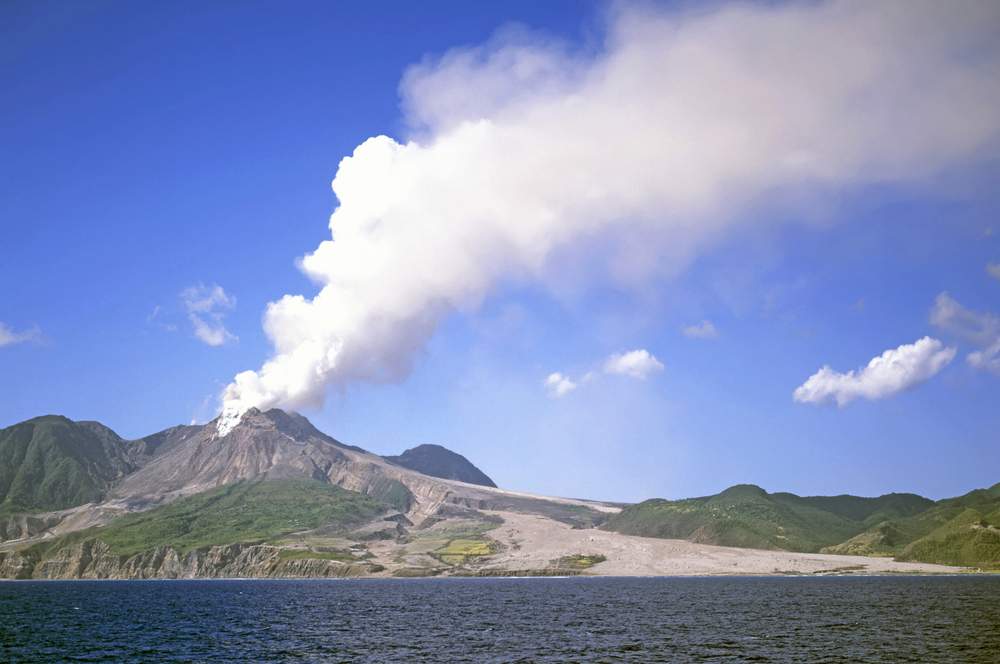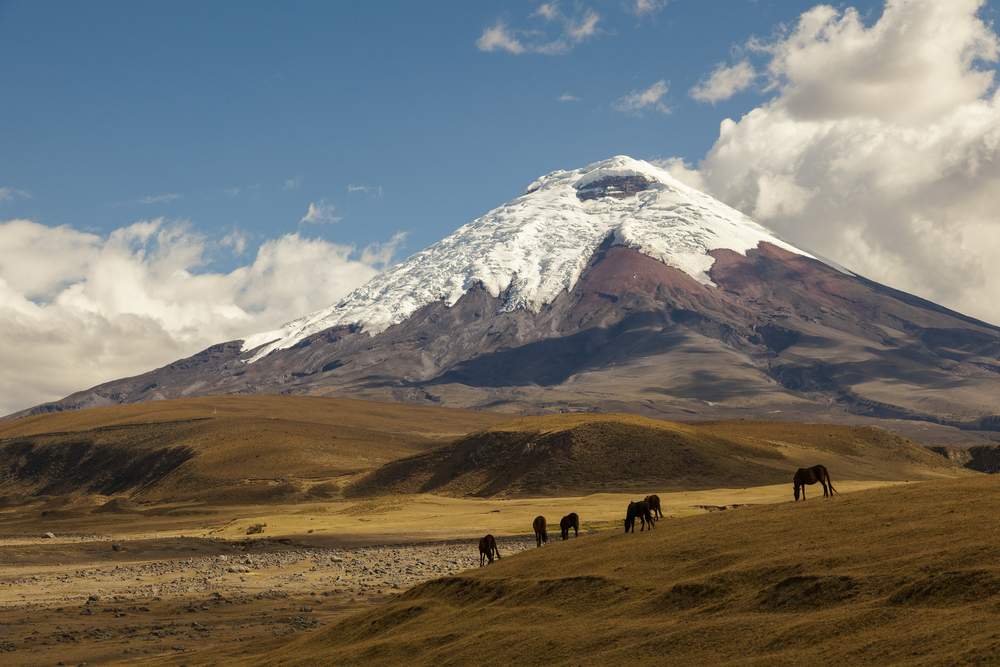So as you make your way around this still-forming planet, consider the following fairly accessible volcanoes for part of your next been-there-done-that party. It goes without saying that climbing or getting close to an active volcano comes with some risks, but most travelers find that those risks lose importance if it means seeing lava, fumaroles, lava tubes, tumbling rocks and volcanoes up close and personal.
Below you’ll find a list of accessible volcanoes for your hiking and viewing pleasure in the Americas.
1. Mount St. Helens – Washington, USA
Since 1987, the southern slopes of Mt. St. Helens have been open to climbers who wish to climb close to (but not into) the crater. Monitor Ridge is a popular trail that starts at Climber’s Bivouac, and takes between 7 and 12 hours to climb. Climbers can gain views of the crater, blast area and other nearby volcanic peaks, but those wishing to climb above 4,800 feet (the rim is at 8,365) need a permit.
Get more details from the Mt. St. Helens official website.
2. Mt. Redoubt – Alaska, USA

Mt. Redoubt is an active stratovolcano that erupted violently in March 2009, and is probably best seen from nearby, as opposed to up close. Climbing Redoubt requires some technical expertise, fixed rope climbing and a peakside scramble to the top, but get up-to-the-minute information before packing your gear (or planning your trip).
3. Tequila Volcano – Mexico
In Mexico, there are a number of volcanoes that can be easily accessed, including Tequila Volcano, where visitors can actually drive to the edge of the crater and peer inside to see the forests that have sprung up inside.
Rock climbers will want to summit “the plug”, a lava column that formed inside the mouth of the volcano and was then thrust upward by geologic pressure. Its sheer walls are not for the uninitiated, nor the acrophobic.
Other climbable volcanoes in Mexico
4. Arenal Volcano – Costa Rica

This starring player in Costa Rica’s ecotourism route is far too active and explosive to be climbed safely. It’s often closed in with clouds, but nighttime visits to the nearby hot springs offer vantage points for seeing the small lava explosions and red-hot rocks tumble forth from the cone.
The area has grown in recent years with Costa Rica’s tourism, and you may find more souls with whom to say “oooh” and “aaaah” than you were expecting.
Several hotels and outfitters in the town of Arenal and nearby Fortuna run tours, and the Arenal Observatory Lodge offers volcano views from right inside.
5. Pacaya Volcano – Guatemala
Guatemala’s Pacaya volcano’s ash-lined slopes have been calling to travelers since the gringo trail first appeared. Volcano-lovers generally stay in the colonial town of Antigua, where tours can easily be arranged, and which is a pleasant, oft-visited spot on its own.
For those aspiring vulcanologists for whom one Guatemalan volcano is not enough, you might consider taking a five-day tour with an outfitter that leads hikers up Pacaya, Sta. Maria, Acatenango and Fuego with camping on the slopes of the volcanoes.
6. Ometepe – Nicaragua

Nicaragua is home to several active volcanoes, including Masaya, which has lava tubes which visitors can explore and even offers tours at night. Nicaragua’s Ometepe Island in Lake Nicaragua is comprised of two volcanoes, Maderas and Concepción, neither of which tops 6,000 feet.
There’s also Cosigüina, in the northwest corner of the country. This dormant volcano’s only 900 meters high, and covered in dense vegetation.
7. Boiling Lake – Dominica
Of sixteen active volcanoes in the Carribean, Dominica is home to nine, and since no significant eruptions have taken place since Columbus’ time, its rainforests remain lush and mostly undisturbed. Visitors to this eco-destination can visit Morne Trois Pitons National Park, a World Heritage site since 1997, named for what was once an enormous volcano.
The park contains several volcanic features, including the hot springs at the Valley of Desolation and a 13 km, 3-4 hour hike up to the world’s second-largest boiling lake, a burping greyish-blue 200-foot-wide lake which geologists believe to be a flooded fumarole.
For those who prefer their waters a little clearer, Dominica also offers an unusual underwater view of volcanic activity in the form of Champagne Reef, an underground vent system that releases sulphuric bubbles that visitors can snorkel or scuba through.
8. Soufrière Hills – Montserrat

The formerly dormant Soufrière Hills volcano on Montserrat came back to life in 1995, triggering fears of an imminent eruption, and chasing half of the island’s 12,000 inhabitants away. In 1997, the volcano made good on its threats, and covered the southern part of the island, including Plymouth, the 200-year-old capital, with a giant, lava-spilling eruption.
An overview (if brief) glimpse of the contrast between the two sides of the island, destroyed and unscathed is perhaps best gleaned from up above, which you can achieve by flying to one of the nearby islands, such as Dominica, a volcanic powerhouse in itself (see above).
9. Villarica Volcano – Chile
Villarica Volcano is 19 km from Pucón, Chile’s adventure sports capital in the Lakes District, in the middle-south of this stringbean of country. Outfitters charge a pretty penny to suit you up with mountaineering boots, a nifty waterproof jumpsuit, helmet, and piolet, or ice axe. A several hour-long climb takes you up to about 9,000 feet, and when the snow cooperates, much of the descent is done on little sleds on snow chutes set up by the guides, and stopped (hopefully) through self-arrest with an ice axe, which has led to more than one emergency-room visit in recent years.
There is also a short ski season during the southern winter up on the slopes of Villarrica and Osorno (near Puerto Varas) volcanoes. The mother of all volcanoes, and the highest (probably active) volcano in the world is Ojos del Salado on the Argentine/Chilean border, but this is a several day trip that requires serious mountain gear.
10. Cotopaxi – Ecuador

Ecuador is home to Pichincha, Riminahui, Cotopaxi, and Chimborazo volcanoes, and of these, Cotopaxi is perhaps the most emblematic and the most frequently climbed, though is does require an overnight at a refuge. At 19,347 feet, it’s the second highest volcano in Ecuador (the first is Chimborazo), but not on the continent. That honor goes to Ojos del Salado, on the Chile/Argentina border (see above)
From Quito, you can hire a guide, though since the starting point of the hike is at nearly 15,000 feet, a number of days’ acclimation in Quito beforehand, as well as climbing some smaller, nearby mountains would be wise. Hikes up Cotopaxi start the day before, gain several hundred feet of elevation over the course of a few hours, and then have climbers resting/sleeping from 6 PM to around midnight. At 1 AM climbers begin their summit attempt. It generally takes approximately 7 hours to summit and 3 to arrive back to the parking lot. For those who just want to get close and then put the volcano behind them, some Quito outfitters offer mountainbike trips down from the park’s entrance.
11. El Misti – Peru
Beautifully symmetrical, El Misti Volcano is 19,101 feet high, and is accessible from “the white city” of Arequipa in Perú, which itself is 2400 meters above sea level, which will help travelers to acclimate. Misti (which means the gentleman in Quechua) last erupted in 1985 and is the source of much of the white stone of which the city itself (the second largest in Peru) is constructed.
This trip takes two days and one night, and gives hikers the chance to descend into one of the three concentric craters, should energy abound. The first day involves a 4×4 trip to the end of the road, followed by a 6-8 hour hike, a night of “sleep” at 4800 meters, and a 4 AM wakeup to make the summit in about five hours. Participants can expect to drink copious amounts of coca tea and be cold, even in their -15C sleeping bags. Tour agencies recommend booking this trip before arriving in Arequipa, as it is quite popular.
If you’ve climbed one of these volcanoes, or another in the Americas, let us know in the comments.
Read about author Eileen Smith at her blog or find out about more volcanoes to visit at your own peril in 12 of the Most Active Volcanoes in the World
Like this story? Sign up for the Daily Dose and get more BootsnAll in your inbox.
Photo credits: JPL Designs, Menno Schaefer, Colin D. Young, iFerol, Adrian Reynolds, Ecuadorpostales